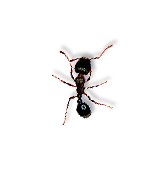General Characteristics:
- 2 to 4 mm; avg. 3.25 mm (1/6 – 1/8 inches; avg. 0.13 in)
- Dark brown with paler legs and antennae
- 12 segmented antennae with 3 segmented club
- Queens and males are both winged, shedding them after mating
- Workers have 2 humps and ridges running from the head to the thorax
- Scavengers that will eat almost anything, but tends to prefer sugars
Reproduction:
- Nests can usually be found under cracks in pavement, but occasionally in walls, insulation or under floors
- Generally more than one queen per colony (polygyne) which fosters a high reproductive rate
- Queen will lay between 5 and 40 eggs per day
- Fertilized eggs will be workers or queens while unfertilized eggs will become males or be eaten by colony
Signs of Infestation:
- Raised sand mounds on or around pavement cracks are a sign of nesting
- Although not damaging to humans or structures, they can contaminate food
- Workers lay down pheromone trails that others follow, so ants may be seen following similar patterns of movement
- Within structures many ants may be observed foraging for food
- With large infestations and numerous colonies, soil may become weak under structures due to excessive nesting and sinking may occur
Control Techniques:
- Sealing structural holes is vital for interior control of this ant species. PLEASE REMEMBER NOT TO SEAL ANY STRUCTURAL BREATHING HOLES AS THESE ARE NECESSARY FOR THE MOVEMENT OF MOISTURE THROUGH VOID AREAS IN A STRUCTURE.
- Sanitation of organic debris will reduce interior food supply and make structure less conducive to ant usage
- We recommend professional consultation if problems persist to determine the most appropriate solution
Please click here to contact a Focus Pest Control professional to inquire about further treatments for this pest species.
References:
Tarkington, L. 2001. "Tetramorium caespitum" (On-line), Animal Diversity Web. Accessed May 15, 2009
at http://animaldiversity.ummz.umich.edu/site/accounts/information/Tetramorium_caespitum.html.
"Welcome to the Pest World" (On-line). National Pest Management Association Inc. Accessed May 15,
2009 at http://www.pestworld.com/for-consumers/Pest-Guide/Pest/Pavement-Ants.
Disclaimer:
The Focus Pest Control ‘Pest Library’ is an educational resource written largely to educate the general public about common pests in Ontario. The Focus ‘Pest Library’ does not include all species in Ontario, nor does it include the most recent scientific data about species we describe. Though we edit our accounts for accuracy, we cannot guarantee all information in those accounts. While Focus Pest Control staff and contributors provide references to books and websites that we believe are reputable, we cannot necessarily endorse the contents of references beyond our control.
(Back to top)
|


